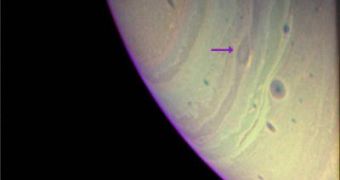A team of researchers from the University of the Basque Country (UPV/EHU) have been monitoring a cyclone on Saturn for over a five-year period, and the images captured by the Cassini probe highly contributed to this study.
This actually makes it the longest-lasting cyclone ever discovered on one of the giant planets in our Solar System.
In 2004, when the Cassini spacecraft began sending images from Saturn, the team started tracking the cyclone, which is about the size of the European continent.
The latest available data on the cyclone are for 2009 (NASA has a one-year policy in terms of releasing images from the Cassini probe), so the researchers are waiting impatiently for the data from 2010, to see how the disturbance has evolved over the past year.
Teresa del Río-Gaztelurrutia, lead author of the study and a researcher at the UPV/EHU Planetary Sciences Group, told SINC that this cyclone is “the longest-lasting one ever seen on the giant planets of the Solar System, Jupiter and Saturn,” and she admitted that “we still know very little about these kinds of structures.”
Nevertheless, the team used mathematical simulations to analyze the vertical structure of the cyclone's clouds, its horizontal morphology and its dynamics.
Based on this they created a model of its internal circulation and the interaction with external winds.
The internal winds of a cyclone are very difficult to measure because of the bad contrast of the images, but the researchers did found out that they were 'not very intense' compared to the cyclone itself.
It is moving at 245 km/h, dragged by a powerful jet stream, and the maximum speed of the winds around its edge is 72 km/h.
The researcher said that “cyclones – where the wind turns in the same direction as the planet – do not usually last for a long time, and so we were interested to discover one that had gone on for several years on Saturn.
“Another reason why it attracted our attention was its visual appearance, which is very reminiscent of the Great Dark Spot on Neptune, which – like the Great Red Spot on Jupiter – is an anticyclone,” she added.
An anticyclone has winds that do not turn in the same direction as the planet's rotation, so it is much more stable, and its vortex lasts much longer than those of cyclones on the giant planets.
But even though it looks like the anticyclone on Jupiter, the cyclone on Saturn has a weak circulation, with properties very similar to those in its close environment.
The Cassini spacecraft is the result of a collaboration between NASA, the ESA and the Italian Space Agency.
These findings have been published recently in the journal Icarus.

 14 DAY TRIAL //
14 DAY TRIAL //